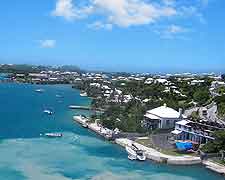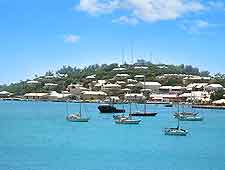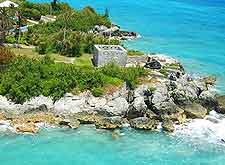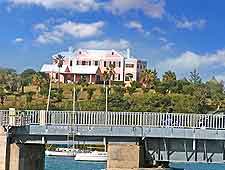St. George's History Facts and Timeline
(St. George's, Bermuda)

The first English settlers arrived on the islands of Bermuda in 1609 and settled in the area of St. George's some three years later.
Originally named New London, St. George's story is one of considerable importance. As the capital of Bermuda until 1815, it played a truly pivotal role in the country's history, while it also helped to shape the USA's history at the same time as its own.
New World's Oldest English Settlement
Although unsubstantiated, St. George's is widely believed to hold the accolade of being the New World's most historic continuously inhabited English settlement. Jamestown in Virginia is often said to have been founded in the year of 1607, although that was under the name of James Fort, with the town's current name only being changed to Jamestown in 1619, seven years after the official foundation of St. George's Town.

Emigration and the US
Many thousands of Bermudians chose to emigrate to America, before the
United States became independent and set up its strict immigration policies. The majority ended up in the state of Virginia or parts of the South-East, with the more affluent families from Bermuda managing much of the trade in the American harbours. St. George's, as Bermuda's principal parish and the most significant port at this time, ultimately played a very important and integral role in Bermuda's overall contribution to development in the US.

The history of St. George's can also be linked to the American War of Independence (1775 to 1783). Locals stole valuable gunpowder from a nearby magazine on Ordnance Island, which was used to supply the forts protecting the Bermudian capital of St. George's Town itself.
Roughly 100 heavy and rather bulky barrels of gunpowder were then smuggled out via nearby Tobacco Bay, before being delivered to none-other than President George Washington himself - the man in charge of this top-secret operation. This act is widely believed to have lengthened the Civil War, since the Confederates had been struggling to obtain supplies of ammunition, a trade which was based in St. George's and thought to have been secure.

Historical Sights
With over 400 years of history, it is not surprising that St. George's is full of significant buildings from yesteryear. Much of the town and parish appear quite similar to their early days of prosperity.
The majority of the most impressive landmarks were built in the 17th, 18th and 19th centuries, being purposely kept intact through restoration work. Among the most significant structures still standing here today are the Old State House, Stewart Hall, the Old Rectory and St. Peter's Church - one of the Western Hemisphere's oldest continually used churches.

World Heritage
In the year of 2001, HRH Princess Anne visited St. George's Old Town, along with other dignitaries, as part of its World Heritage accreditation and ceremony.
The United Kingdom had recommended that St. George's be added to the UNESCO World Heritage List, due to its numerous historically significant buildings and surrounding fortifications, such as the remains of the 17th-century fortress on Castle Island.
 The first English settlers arrived on the islands of Bermuda in 1609 and settled in the area of St. George's some three years later.
The first English settlers arrived on the islands of Bermuda in 1609 and settled in the area of St. George's some three years later.
 The history of St. George's can also be linked to the American War of Independence (1775 to 1783). Locals stole valuable gunpowder from a nearby magazine on Ordnance Island, which was used to supply the forts protecting the Bermudian capital of St. George's Town itself.
The history of St. George's can also be linked to the American War of Independence (1775 to 1783). Locals stole valuable gunpowder from a nearby magazine on Ordnance Island, which was used to supply the forts protecting the Bermudian capital of St. George's Town itself.
